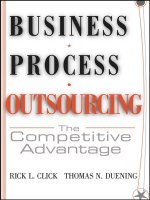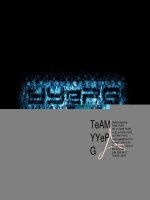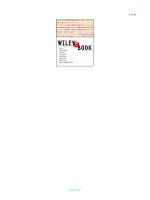John wiley sons sap bw certification a business information warehouse study guide
Bạn đang xem bản rút gọn của tài liệu. Xem và tải ngay bản đầy đủ của tài liệu tại đây (256 KB, 355 trang )
TE
AM
FL
Y
SAP BW Certification
A Business Information Warehouse
Study Guide
Catherine M. Roze
John Wiley & Sons, Inc.
SAP BW Certification
A Business Information Warehouse
Study Guide
Catherine M. Roze
John Wiley & Sons, Inc.
This book is printed on acid-free paper. ∞
Copyright © 2002 by John Wiley & Sons, Inc., Hoboken, New Jersey. All rights reserved.
Published simultaneously in Canada
No part of this publication may be reproduced, stored in a retrieval system, or transmitted in any form or by any
means, electronic, mechanical, photocopying, recording, scanning, or otherwise, except as permitted under Section
107 or 108 of the 1976 United States Copyright Act, without either the prior written permission of the Publisher,
or authorization through payment of the appropriate per-copy fee to the Copyright Clearance Center, Inc., 222
Rosewood Drive, Danvers, MA 01923, 978-750-8400, fax 978-750-4470, or on the web at www.copyright.com.
Requests to the Publisher for permission should be addressed to the Permissions Department, John Wiley & Sons,
Inc., 111 River Street, Hoboken, NJ 07030, 201-748-6011, fax 201-748-6008, e-mail:
Limit of Liability/Disclaimer of Warranty: While the publisher and author have used their best efforts in
preparing this book, they make no representations or warranties with respect to the accuracy or completeness of
the contents of this book and specifically disclaim any implied warranties of merchantability or fitness for a
particular purpose. No warranty may be created or extended by sales representatives or written sales materials.
The advice and strategies contained herein may not be suitable for your situation. You should consult with a
professional where appropriate. Neither the publisher nor author shall be liable for any loss of profit or any other
commercial damages, including but not limited to special, incidental, consequential, or other damages.
For general information on our other products and services, or technical support, please contact our
Customer Care Department within the United States at 800-762-2974, outside the United States at 317-572-3993 or
fax 317-572-4002.
Wiley also publishes its books in a variety of electronic formats. Some content that appears in print may not be
available in electronic books.
Library of Congress Cataloging-in-Publication Data:
Roze, Catherine M.
SAP BW certification : a business information warehouse study guide / Catherine M. Roze.
p. cm.
Includes index.
ISBN 0-471-23634-9 (pbk. : alk. paper)
1. SAP Business information warehouse—Examinations—Study guides. 2. Data warehousing—
Examinations—Study guides. 3. Management information systems—Examinations—Study guides.
4. Business—Computer programs—Examinations—Study guides. I. Title.
HF5548.4.B875 R69 2002
650' .0285 '5785—dc21
2002010153
Printed in the United States of America
10
9
8
7
6
5
4
3
2
1
Contents
Foreword
v
Preface
Chapter 1
vii
Enterprise Resource Planning, Business Intelligence,
Data Warehouses, and SAP BW
1
Chapter 2
Certification Exam
13
Chapter 3
Training
25
Chapter 4
Data Modeling
32
Chapter 5
Building Blocks
78
Chapter 6
Reporting
116
Chapter 7
Extraction
160
Chapter 8
Getting Ready for Certification: Tips and Tricks
187
Chapter 9
Simulated Certification Test
196
Appendix A
SAP BW and Data Warehousing Resources
213
Appendix B
SAP BW Quick Reference Guide
227
Appendix C
SAP BW R/3—Related Quick Reference Guide
23 2
Appendix D
SAP BW 3.0 New Features
239
Appendix E
SAP BW Training Offerings: Course Descriptions
288
Appendix F
Roles and Skills for BW Projects
301
iii
iv
Contents
Appendix G
SAP BW White Paper
311
Appendix H
SAP BW Standard Business Content
317
Glossary
323
Index
333
Foreword
In recent years, companies have replaced dozens of legacy systems and years of business
data with a new ERP system to address the integration and modernization of daily transactions that run the business. As part of this process, they redesigned business processes and
often developed new process measurements. SAP was often the ERP system of choice.
After having implemented ERP, most organizations found that these systems were good
for gathering data, executing transactions, and storing data. Still, organization after organization discovered that getting information out of ERP systems was difficult.
In the face of increased pressures due to globalization and rapidly changing markets, these
ERP customers have felt an increased need to use information as a competitive advantage for
decision making while constantly monitoring and improving their business processes. They
also require new data views to facilitate comparative studies and measurement of performance in order to increase their ability to achieve their tactical and strategic objectives.
Listening to the needs of its customers, SAP developed the Business Warehouse (SAP
BW), an end-to-end data warehousing solution that has been gaining in acceptance. It is an integrated solution that includes not only the traditional data warehousing technology but also
the supporting technology such as queries, reports, and key performance indicators, InfoCubes, InfoSources, and preconfigured extraction modules.
Many ERP customers worldwide are evaluating or implementing SAP BW to convert
large amounts of data into integrated information systems. Because of the complexity of
these business information systems there is a significant need for qualified SAP BW skilled
analysts and consultants. If you are an analyst or consultant with SAP, ERP, or Business Intelligence skills, acquiring SAP BW certification is a must in further developing your skills.
While training is an important part of acquiring SAP BW skills, this book is an effective
way to prepare for the certification test and to use your newly acquired knowledge. SAP BW
certification covers several knowledge areas and this book will help you prepare for the exam.
Catherine Roze is a consultant with excellent knowledge of Business Intelligence and
SAP BW in particular. She has been involved in a wide variety of projects and has put her
practical experience to work in this book. The technical information on SAP BW has been organized in a simple and effective manner allowing you to quickly acquire the knowledge required. The sample questions prepare you for the exam. The book also contains a wealth of
information that makes it a great reference when implementing SAP BW.
I am sure that you will find this book an excellent guide, reference, and invaluable aid in
preparing for the SAP BW certification.
MR. MEENAKSHISUNDARAM (Meenasi) VENKATASUBRAMANIAM
Practice Executive
SAP Process Integration
IBM Global Services
v
Preface
The SAP Business Information Warehouse (SAP BW) Certification Test program is a rigorous testing and certification program for SAP BW practitioners. This book is a concise, comprehensive study guide to the areas covered on the SAP BW certification exam.
SAP offers consultants the opportunity to be recognized for their skills as an SAP Certified Consultant. Recognized worldwide, the certificate evidences their ability as a highly qualified SAP BW consultant to the marketplace. Certified consultants can also access the SAP
information network, keeping their knowledge up-to-date to benefit customers.
The certification test for becoming an application consultant for SAP BW is intended to
provide candidates with the opportunity to prove that they have a fundamental knowledge of
this particular area of the SAP system and are able to apply this knowledge within a project
environment.
Mission
The primary mission of this book is to provide a practical approach and strategies to help
you prepare and pass the SAP BW Certification exam. In most cases, this study guide is not
intended as a substitute for the classroom training offered by SAP, but rather to complement
it. Therefore, it is usually best to take the test after having attended the SAP BW classroom
training provided by the SAP education centers.
This book is designed to present SAP BW concepts in a clear and concise fashion. I have
created this text specifically to help you identify the information that you need to know to prepare for the SAP BW Certification exam and give you an edge to pass.
What You Will Find in This Book
The book provides information about the exam, training offerings by SAP, a study guide,
sample test questions, suggested exercises and one simulated certification test. This book
covers the core (required) subject areas for the SAP Business Information Warehouse (SAP
BW) certification:
SAP BW Data Modeling. Basic concepts and techniques for data modeling in traditional
data warehouses and SAP BW
SAP BW Building Blocks. Basic concepts and tools of the configuration, technical architecture and warehouse management of the SAP Business Information Warehouse
vii
viii
Preface
SAP BW Reporting. SAP BW reporting and analysis tools
SAP BW Extraction. Mechanisms to extract data from SAP and non-SAP data sources
within SAP BW
Useful reference information is also provided to assist you in becoming more knowledgeable
and proficient in SAP BW, including SAP BW quick reference guide, SAP training offerings,
and a list of useful on-line and published resources on data warehousing, business intelligence, SAP R/3, and SAP BW.
Target Audience
TE
AM
FL
Y
The audience for this book consists of all SAP Business Information Warehouse practitioners
who wish to pass the SAP BW certification exam. This includes practitioners experienced in
the subject matter areas – SAP BW, business intelligence, or SAP R/3 areas and beginners in
SAP BW:
Technical and functional consultants for SAP BW
Certified SAP R/3 technical consultants interested in working in the SAP BW environment
SAP BW partners and consultants
SAP BW power users
Project managers and team leaders of SAP BW implementations
SAP BW practitioners seeking re-certification to current SAP BW release (Delta examination).
SAP BW Experienced Professionals
If you are experienced in the subject matter area—SAP BW, Business Intelligence/Data
Warehousing, or SAP R/3 areas—this study guide will help you codify your knowledge, understand SAP’s view of the universe, and prepare for the SAP BW certification exam. It will
also aid those practitioners preparing for the SAP BW Delta examination (re-certification to
current release).
SAP BW Beginners
If you are a beginner in SAP BW, this study guide should also prove useful. You will need
real world experience that no book can provide and depending on your background, you
may also need help from one or more resources such as Business Information Warehouse for
SAP (Portland, OR: Premier Press, 2000) by Naeem Hashmi; SAP BW Reporting Made Easy,
2.0/2.1C (Palo Alto, CA: SAP Labs, Inc., 2001) by SAP Labs, Inc., Simplification Group; or
classroom training.
Team-Fly®
Preface
ix
Which SAP BW Versions Are Covered?
As SAP updates SAB BW in new releases, we expect most of the changes to be in the look
and feel of the software and not the basic SAP BW concepts and process. As such you may
find that some screens used in this book, terminology or software functionality or screens
might have changed.
At this time, SAP BW certification exams are version independent. To keep this version
independence in mind, you will find this book to be version neutral as it describes the SAP
BW certification process.
The Author has attempted to provide sufficient guidelines to qualify exam with contents
and hundreds of questions that will be valid for both SAP BW 2.1C and SAP BW 3.0.
Where appropriate, critical areas have been flagged when significant differences exist between BW 2.1C and BW 3.0, and additional reference and study material are provided for details.
The main intent of this book is to provide a practical approach to help you get certified in
SAP BW. Its goals are not to present version-specific details and features but rather to be as
version-independent as possible. To provide the required information while avoiding unnecessary confusion for the reader, the following has been done:
When appropriate, the major changes between SAP BW releases are highlighted within
the technical chapters (chapters 4, 5, 6, and 7) with a “New” icon.
Appendix D presents new features in SAP BW 3.0.
Additional resources provide more details regarding new developments in SAP BW.
In the future, our Web site will also provide information and links to new features and
changes in SAP BW.
What This Book Covers
The book includes the following chapters:
Chapter 1: Enterprise Resource Planning, Business Intelligence,
Data Warehouses, and SAP BW
This chapter provides a general introduction to the main themes herein: ERP, SAP, Business
Intelligence, Data Warehousing, OLAP and SAP BW. Concepts in this chapter are not explicitly tested on the exam but are important to understand.
Chapter 2: Certification Exam
This chapter is a brief introduction to the SAP BW certification exam. It provides key information regarding the exam process, rules and logistics including prerequisites and certification requirements.
To assist you in prioritizing your efforts, it also suggests the relative weighting that these
questions may carry on the exam.
x
Preface
Chapter 3: Training
This chapter is a brief introduction to the SAP BW Training offerings by the SAP Education
Centers. It provides key information regarding the classroom training for SAP BW, prerequisites, resources, location, scheduling, and enrollment.
Chapter 4: Data Modeling
This chapter provides basic concepts and techniques of data modeling in traditional data
warehouses and the SAP Business Information Warehouse.
Chapter 5: Building Blocks
This chapter provides basic building blocks for the architecture, configuration, and data
warehouse management for the SAP Business Information Warehouse.
Chapter 6: Reporting
This chapter presents SAP BW reporting and analysis tools and concepts. You will learn SAP
BW queries and reports design and management techniques, including Web reporting and
authorizations.
Chapter 7: Extraction
This chapter describes the tools and mechanisms to extract data from SAP and non-SAP data
sources into SAP BW.
Chapters 4, 5, 6, and 7 are organized based on the following structure:
Study Guide. This is a comprehensive study guide for the areas covered on the exam. It
can be read straight through or serve as a reference for the areas in which you feel that
you need further study.
Suggested Exercises. This section provides a list of exercises that you can perform,
usually with a small test SAP BW server, to gain experience in the exam’s subject
area.
Practice Tests. This section includes comprehensive test questions to assess your
knowledge of the current exam topics and readiness for taking the exam. These questions are similar in content and format to those of the actual SAP BW certification
exam.
The questions on the certification exam are either one answer only or more than one
answer. Because the questions on the certification exam usually indicate if a single answer or more than one answer is expected, the questions have been separated accordingly
for studying purposes.
Answers to Practice Tests. This section provides answers to the questions from the practice tests. You should take the opportunity to review incorrect answers to identify those
subject areas where you need additional review before attempting the exam.
Preface
xi
Chapters 8 and 9
These chapters offer
Test-taking tips to maximize test performance
SAP BW certification exam simulation to judge exam readiness
How to Use This Book and Pass the SAP BW Exam
To be successful in the SAP BW certification, follow these 10 steps for success and pass the
SAP BW certification test:
1. Review chapters 1, 2, and 3 of this study guide to become familiar with the concepts, certification process, and training options.
2. Become familiar with the SAP BW concepts and terminologies by studying the key concepts in the study guide. Understand the test objectives for the SAP BW test by reading
SAP BW Exam Content & Weighting (chapter 2).
3. Depending on your knowledge and experience level, attend one or more of the SAP BW
curriculum training provided by SAP.
4. Read the “SAP BW Certification Study Guide” in detail.
5. Study additional resources and training materials as needed in the SAP BW and data
warehousing areas.
6. Test your knowledge with the practice exam questions throughout the book.
7. Do a thorough review of the objectives and use the answers to the practice tests to learn
from your mistakes and solidify the information in your head.
8. Take the simulated certification exam at the end of the book. Give yourself an hour and
a half for each test and follow the Test-Taking Tips and Hints.
9. Schedule your exam with SAP Education Center (Internet or SAP
central registration 888-777-1727).
10. Practice, Practice, Practice.
This study guide includes comprehensive test questions to assess your knowledge of the current certification exam topics and readiness for taking the exam. These questions are similar
to both the content and format of the SAP BW certification questions.
Use this study guide or have someone ask you the questions to be sure you are prepared
for the test. Don’t be satisfied if you merely know 95% of the topics the exam covers. The
questions are moderately hard and are a good test of your overall comprehension and will
help you identify the areas where further study is needed.
You should not underestimate the difficulty of the SAP BW certification exam because
you can probably expect to find harder questions on the actual exam. You should take the opportunity to review incorrect answers to identify the subject areas in which you need improvement before attempting the exam.
Be especially aware and knowledgeable about the benefits and restrictions listed in the
study guide for the different components of SAP BW. For instance, the test questions will
probe your knowledge of the benefits and restrictions of the star schema in regards to the
xii
Preface
minimum and maximum number of dimensions and key figures or the benefits and restrictions of ODS, PSA, and InfoCubes in regards to type of data to be stored.
Throughout the study guide you will find the following icons that identify special content.
Information about areas that you should study for the certification exam and the type
of questions that you should expect
Suggestions for improving performance of the SAP Business Information Warehouse
in the areas of queries execution, data extraction, and overall system
These tips are directly related to the exam and you should expect questions on the
certification test.
The limitations and specifics of SAP BW for a particular subject area
They are directly related to the exam and you should expect questions to test your
knowledge of these restrictions.
The unique features of SAP BW when compared to traditional data warehousing and data
modeling
You should also be prepared for questions assessing your comprehension.
✍
Useful notes to enhance your understanding or help you clear up confusion
These notes will probably not be directly generating questions on the exam.
The major changes between SAP BW releases 2.1C and 3.0
Preface
xiii
Your Feedback
The information herein is provided on an “as is” basis. The author and John Wiley & Sons,
Inc. shall neither be liable nor responsible to any person or entity with respect to any loss or
damages arising from the information contained in this book.
This book is designed to provide information about the SAP BW certification exam.
While every effort has been made to make this book as complete and accurate as possible, no
warranty or fitness is implied. We have tested and verified the information in this book to the
best of our ability, but as no human endeavor is perfect, we may have made an occasional error, notwithstanding our diligent efforts.
As the reader of this book, you are the most important critic and commentator. We value
your opinion and want to know what we are doing right, what we could do better, what areas
you would like to see us publish in, and any other words of wisdom you are willing to pass
our way. Please let us know about any errors you may find, as well as your suggestions for future editions by writing to me electronically at When you write
please be sure to include your name, phone and fax number, and we will carefully review your
comments. We have a Web site for the book where we will list examples, errata, and any plans
for future editions at www.certificationsap.com.
I wish you good luck in your pursuit of a career in SAP BW.
Dedication
When I told my family and friends that I was writing a book, they thought it sounded like a
really good idea. I do not think any of us realized the time, energy, and commitment that
would be eventually required.
I would like to dedicate this book to the friends and families who supported me in my effort to write it.
Acknowledgments
A number of individuals contributed to this book and I would like to give credit and thank
everyone involved for their help and support.
First, I would like to thank Robert Chiarelli, Sheck Cho, and John Wiley & Sons for this
opportunity to share my experiences and knowledge in the ever evolving industry of business intelligence and SAP BW.
The quality and consistency in this book would not have been possible without the support of the editorial staff at John Wiley & Sons, especially Sheck Cho and Jennifer Gaines,
who spent time editing, organizing, and packaging the material in this book. Their support is
very much appreciated.
The manuscript was also reviewed for technical accuracy at various stages by Naeem
Hashmi. His input has given me added inspiration while helping make this a better and more
interesting book. His expertise in SAP BW was invaluable, especially in organizing the book
and creating the performance optimization tips.
I would like to thank Mr. Arka Mukherjee of IBM. He introduced me to SAP BW in 1999
upon my joining IBM and gave me the opportunity to start working in this field. When I presented my vision for this book to him, he encouraged me to proceed and gave me the inspiration to start this endeavor.
There is a group of business intelligence and SAP BW practitioners and friends that I
also would like to thank for reviewing chapters and providing useful suggestions for refining
some of my ideas and clarifying points. They include Richard Dunning, chairperson for the
SAP BW American SAP Users Group (ASUG); Joffy Matthew, Doug Childs, and Phil Harrington of the Enterprise Data Group; and Marv Jackson of IBM Global Services.
A very special thanks goes to my friend and mentor, David Moss, for his patience, encouragement, and support in writing this book. My friends Violaine Galland and Bruce
Urquhart were also helpful in providing resourceful suggestions and moral support.
I wish to acknowledge the kind assistance of SAP AG, especially Laurie Nolan, Director,
Americas BW Product Marketing; SAP Portals; and Bernhard Hochlehnert, Head Global Customer Affairs, SAP AG.
I would like to thank those with whom I did not work directly, but who worked behind the
scenes and were instrumental in bringing this book to publication: production staff, cover designer, and graphic artists.
I cannot forget the delivery people who kindly brought nourishment to me during the
crash production periods of this book.
Last but not least, I would like to thank the readers of this book. The SAP Business Information Warehouse (SAP BW) is still evolving rapidly, and writing about a moving target is
not an easy task. I wish them all the best in the SAP BW certification exam and their SAP
BW endeavors.
xiv
CHAPTER
1
Enterprise Resource Planning,
Business Intelligence, Data
Warehouses, and SAP BW
In This Chapter:
Enterprise resource planning (ERP)
SAP R/3
Business intelligence
Data warehousing
OLAP
ERP data warehousing
SAP Business Information Warehouse (SAP BW)
This chapter provides a general overview and background to enterprise resource
planning (ERP), SAP R/3, business intelligence, data warehousing, OLAP, and the
SAP Business Information Warehouse (SAP BW), the main themes of this book.
The contents in this chapter are not explicitly tested on the exam, but provide important background information. This section will assist you in answering generalpurpose questions on the exam related to these topics.
1
2
Enterprise Resource Planning, Business Intelligence, Data Warehouses, and SAP BW
Enterprise Resource Planning
Enterprise Resource Planning Systems (ERP) are commercial software packages that facilitate the seamless integration of all the information flowing through a company—financial,
accounting, human resources, supply chain, and customer information. ERP systems fundamentally integrate the different processes necessary in a business into a centralized pool that
facilitates data sharing and eliminates redundancy. ERP provides information management
and analysis to organizations.
The major benefits of ERP systems include:
On-line/real-time information made available throughout all the functional areas of an organization
Improved data standardization and accuracy across the enterprise
“Best practices” included in the applications
The efficiency gained throughout an organization
The analysis and reporting made available for long-term planning
The major players in the ERP software industry are Baan, J. D. Edwards, Lawson, PeopleSoft, Oracle, and SAP. Examples of ERP modules are human resource management systems
(HRMS), financials, manufacturing, distribution, and sales. Each ERP module offers different
functionality for different industries.
SAP R/3
The German software company SAP AG is the market leader in the ERP arena. Systems, Application and Products in Data Processing (SAP) consists of highly integrated software modules that perform common business functions based on multinational leading practices.
SAP R/3 is the third generation of SAP software. SAP R/3 is based on a client/server architecture and uses a relational database to track all information related to a corporation.
SAP R/3 runs on several operating systems, including UNIX, Windows NT, and AS/400, and
can use different database management systems, including Oracle, DB2, Informix, and Microsoft SQL Server.
The SAP R/3 client/server system architecture is built around several modules or applications. A module is a set of transactions that deal with the same area of business functionality.
The current modules of SAP R /3 include:
FI—Finance
CO—Controlling
MM—Materials Management
HR—Human Resources
PM—Plant Management
PP—Production Planning
LO—Logistics
SD—Sales and Distribution
One of the reasons for the success of SAP R/3 is the tight integration of the business applications. One event in one module, such as materials, automatically triggers response in the others, such as sales, finance, and plant maintenance. For instance, when a customer places an
Business Intelligence, Data Warehousing, and On-Line Analytical Processing
3
order, a purchase order is created, an inventory is created, appropriate documents are created,
and so on. This functionality is a major advantage compared to that offered by other vendors
who simply package the business functionality in one box with limited integration.
Business Intelligence, Data Warehousing, and On-line
Analytical Processing
Data Warehousing and Business Intelligence
The twenty-first century belongs to those who exploit information as a strategic enterprise resource. Today’s decision makers urgently need accurate information on production, sales and
markets, finance, and personnel to obtain a complete and up-to-date picture of their business
and environment. As illustrated in Exhibit 1.1, that information is usually spread throughout
the corporate IT structure, on a wide variety of platforms and in a wide range of applications. In other words, getting hold of vital facts and figures can be a complex and timeconsuming task.
Exhibit 1.1
Business Intelligence Reality: Islands of Information
Enterprise Resource Planning, Business Intelligence, Data Warehouses, and SAP BW
The technical concept for meeting this data challenge is known as data warehousing. A
data warehouse is a separate application environment with a dedicated database drawing on
diverse data sources and designed to support query and analysis.
“Business Intelligence is the process of transforming data into information and transforming that information into knowledge through discovery.”1 Data warehousing and other
business intelligence tools give meaning to all of that “useless” data. Using data warehousing and business intelligence functions, strategic decision makers can analyze, slice and
dice, query, and generate reports. Closer integration of corporatewide data warehousing
data with ERP data potentially enhances companies’ return on their ERP and data warehouse investments.
On-line Analytical Processing
AM
FL
Y
One significant functional component of business intelligence is on-line analytical processing
(OLAP). The OLAP Council defines OLAP as a category of software technology that enables
analysts, managers, and executives to gain insight into data through fast, consistent, interactive access to a wide variety of possible views of information that has been transformed from
raw data to reflect the dimensionality of the enterprise as understood by the user.2
OLAP functionality is characterized by dynamic multidimensional analysis of consolidated enterprise data supporting end-user analytical and navigational activities, including:
Calculations and modeling applied across dimensions, through hierarchies, and/or across
members
Trend analysis over sequential time periods
Slicing subsets for on-screen viewing
Drill-down to deeper levels of consolidation
Reach-through to underlying detail data
Rotation to new dimensional comparisons in the viewing area
TE
4
While OLAP systems can answer “who and what” questions, it is their ability to answer
“what, if, and why” questions that differentiates them from data warehouses. OLAP enables
decision making about future actions. A typical OLAP calculation is more complex than simply summing data, for example, “What would be the effect on soft drink costs to distributors
if syrup prices went up by $.10/gallon and transportation costs went down by $.05/mile?”
OLAP and data warehouses are complementary: A data warehouse stores and manages
data. OLAP transforms data warehouse data into strategic information. OLAP ranges from
basic navigation and browsing (often known as “slice-and-dice”), to calculations, to more serious analyses such as time series and complex modeling. As decision makers exercise more advanced OLAP capabilities, they move from data access to information to knowledge.
ERP Data Warehouses
The demand for data warehousing functionality for ERP systems has been growing exponentially as companies strive to gain and maintain a competitive advantage and executives are realizing that an ERP implementation alone does not provide the business intelligence edge that
they need to take full advantage of emerging front-office applications such as supply chain
management, sales force automation, and customer
relationship management.
®
Team-Fly
Business Intelligence, Data Warehousing, and On-Line Analytical Processing
5
To improve the quality and accuracy of decision making in these areas, decision makers and business analysts need full integration and access to ERP and other source system
data. However, some major hurdles prevent the flow of ERP data to business intelligence
systems such as data warehouses. In response to these challenges, ERP vendors, data
warehousers, and third-party tool vendors developed numerous products and solutions to
meet this demand.
Aside from building a data warehouse from scratch, the three basic categories of vendorbased data warehousing solutions include:
1. Solutions from third-party vendors that analyze data within ERP systems
2. ERP-based solutions that analyze data within ERP systems
3. ERP-based solutions that build data warehouses outside their ERP systems
An ERP-based data warehouse is a classical, external data warehouse or data mart built with
tools offered by an ERP vendor. Oracle and SAP are currently the only major ERP vendors
with such offerings. Sooner or later other ERP vendors such as PeopleSoft and Baan will enter
the market.
Limitations of ERP Data Warehouses
There has been a lot of skepticism about ERP vendor offerings of data warehouses. Wayne
Eckersen, vice president of the Data Warehouse Institute,3 stated that:
The promise of closed-loop decision support gives the ERP vendors an advantage in
building next-generation data warehouses. But making the leap from transaction
systems to analytic applications involves a radical shift in the way systems are designed, developed, and used. It’s not self-evident that ERP vendors will master the
art of building decision support tools or analytic applications, let alone linking the
two together to create a closed-loop environment. This gives data warehousing vendors an opportunity to compete as the markets for ERP systems and data warehouses converge.
Data warehouse professionals are not the only skeptics of ERP-based data warehousing
solutions. In an article entitled “ERP Users Face Data Warehouse Dilemma,”4 Frank Gillette, a
Forrester, Inc. analyst, expressed doubt that ERP vendors are qualified to build data warehouses, saying, “You do not want to have data extraction and transformation going on in the
same database that you run your transactions in.”
The prime reason for this skepticism by the analysts in accepting ERP data warehouse
initiatives can be traced back to the “cultural issues” as Naeem Hashmi, CTO of Information
Frameworks, documented in his article “Mix It Up.”5 This article explains what ERP data
warehousing really means and identifies the traditional and ERP-centric data warehouse evolution and the cultural issues.
Three major limitations of ERP applications prevent the productive flow of data for business intelligence:
1. ERP applications are designed to support high-volume transaction-level activity using
highly normalized data structures; they are not designed to support business intelligence
functions such as ad-hoc querying, reporting, and analysis.
6
Enterprise Resource Planning, Business Intelligence, Data Warehouses, and SAP BW
2. ERP applications do not store historical data that are needed for trend analysis.
3. Finally it is notoriously difficult to access and analyze data in ERP applications, especially in SAP. Therefore ERP’s limitations cause considerable difficulty when linking business intelligence and ERP technologies.
SAP Business Information Warehouse (SAP BW)
The SAP Business Information Warehouse (SAP BW) is a state-of-the-art, end-to-end data
warehouse solution developed by SAP. As pictured in Exhibit 1.2, SAP BW provides knowledge workers and decision makers with rapid access to data from SAP R/3 systems, other enterprise applications, and external sources, such as Nielsen.
Based on proven SAP R/3 client/server technology and exploiting SAP’s acknowledged business expertise, SAP BW combines state-of-the-art data warehousing technologies with SAP AG’s expertise to create an end-to-end solution. It includes all the
components required for installation, use, ongoing changes, and maintenance of a data
warehouse.
The content-rich SAP BW sets a precedent for speed and ease of implementation and
maintenance because it is preconfigured with intelligence about a company’s business
SAP BW Integrates Data from SAP R/3 and Other Enterprise Applications
Exhibit 1.2
SD
Sales &
Distribution
FI
MM
Materials
Mgmt.
PP etc.
Production
Planning
SM etc.
Service
Mgmt.
QM
Quality
Mgmt.
etc.
CRM
Financial
Accounting
CO
Controlling
AM
SEM
Fixed Assets
Mgmt.
Profitability
Customer
Purchasing
SAP R3
SAP BW
PS
Controlling
Project
System
PM
WF
Plant
Maintenance
Workflow
HR
IS
Human
Resources
Industry
Solutions
APO Demand
Planning
Inventory
SCM
Finance
Vendor
HR
Flat
Files
SAP Business Information Warehouse (SAP BW)
7
processes, providing a faster return on information. This new-generation solution provides
users with a comprehensive view of data across an organization, including SAP R/3-based
data as well as data from other systems.
SAP BW Drivers
When the ERP environment is SAP, the majority of the users face multiple problems in accessing, analyzing, and reporting of data. These problems prevent end users from easily accessing both current and historical data for better decision making.
It is difficult to extract customized reports from SAP R/3 and access enterprisewide analytical data while users are provided with a limited set of options:
Build custom programs for each new reporting requirement.
Use SAP’s predefined reports—if you know where to find them.
Do without the data.
Custom SAP reports can be written using Advance Business Application Programming
(ABAP), a proprietary SAP coding language. ABAP reports, while costly, do not solve the
problem because:
They are static. They do not support ad-hoc querying capability.
They are expensive to maintain. All changes have to be manually incorporated by ABAP
programmers.
They negatively impact the performance of the transaction system.
Integration of SAP and non-SAP data is difficult because data extraction from SAP is a difficult task and requires knowledge of SAP data structure and contents. As a consequence, flexible access to enterprisewide information becomes very difficult. Many organizations have
tried to solve this problem by building data warehouses taking data feeds from SAP and nonSAP systems.
Alternative solutions exist but lack flexibility and ease of use. These attributes are essential if the data are to be exploited profitably. None of the available approaches optimally address key aspects of a desirable solution:
SAP R/3 ERP information systems. While the SAP Logistics Information Systems are
quite flexible in permitting multidimensional querying, significant issues remain:
All the data that compose the multidimensional cubes have to be available in SAP R/3
whereas most organizations have a significant amount of enterprisewide data in nonSAP transaction processing systems.
Use of the Logistics Information System (LIS) requires significant training, and end
users need knowledge of SAP data before LIS cubes can be customized.
The execution of queries to LIS has a negative impact on SAP/R3 transaction processing performance.
Third-party solutions. Third-party solution products are available to extract data out of
SAP from multiple vendors. These products are components of a business intelligence solution rather than being an end-to-end solution.
Custom data warehouse solutions. The creation of custom data warehouses taking data
feeds from SAP and non-SAP systems is usually an expensive project that takes years to
implement and usually has limited success due to the following issues:
8
Enterprise Resource Planning, Business Intelligence, Data Warehouses, and SAP BW
If the Metadata in the data warehouse are not synchronized with SAP/R3, the data
warehouses can quickly lose relevance.
Extracting data from SAP R/3 to obtain the data feeds has traditionally been a difficult task, because it relies on the underlying data model and data definitions.
The integration effort is often plagued with difficulties, because different OLTP systems utilize disparate data.
SAP BW Features and Functionality
SAP BW is an end-to-end data warehousing solution with multiple features and functionality:
The SAP BW server includes an OLAP engine and a metadata repository, both of which
are preconfigured with business content, saving the time and money that would be necessary to build a data warehouse from scratch. The SAP BW server is designed to provide
fast retrieval, interpretation, and preparation of the information stored in its data stores.
The Business Explorer provides customers with a new easy-to-use multidimensional data
access interface. The Business Explorer’s navigation capability allows customers to build
a personal catalog of reports for ongoing or recurring queries and reports displaying
data using Microsoft Excel.
In addition to Business Explorer, the latest version of SAP BW 3.0 also includes a
new Web-based multidimensional analysis environment to develop and publish analytical applications for the Internet community.
Automated data extraction and loading capabilities supply the SAP BW server with data
from SAP R/3 applications, SAP R/2 applications, and non-SAP applications and external
sources using flat files or using certified third-party extraction tools for any other data
source.
The Administrator Workbench, another feature of SAP BW, provides a single point of
control for creating, monitoring, and easily maintaining the complete data warehouse environment, reducing the total cost of ownership to customers.
SAP BW embodies all the advantages of leading-edge SAP R/3 BASIS technology with
its multitier architecture: security, integrity, scalability, high availability, and interoperability within a uniform environment.
Desirable reporting architecture and features:
SAP BW includes a proven, consistent enterprise data model for the application of
business rules to data. This builds on the enterprise model of SAP R/3 and greatly facilitates data warehouse implementation and management.
Preconfigured information models and reporting templates help users generate reports quickly and simply.
SAP BW supports predefined standard reports and ad-hoc analysis; both allow drilldown and multidimensional views.
Users can define their own collections of favorite reports, enabling them to access relevant information at the “touch of a button.”
SAP BW is built for high performance. It resides on its own dedicated server. OLTP
and reporting activities are therefore separated, and OLTP system performance is not
compromised. Report caching mechanisms have also been carefully designed to
maintain high performance.









